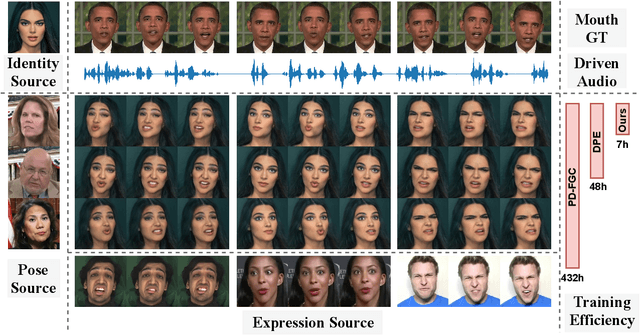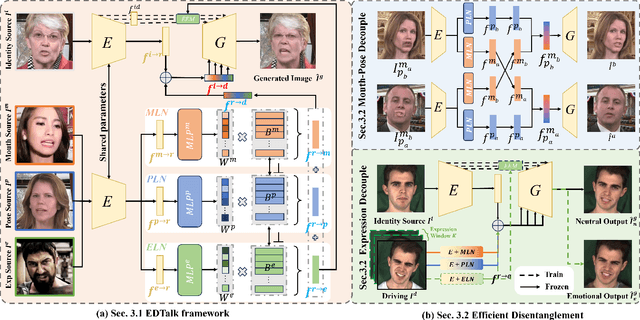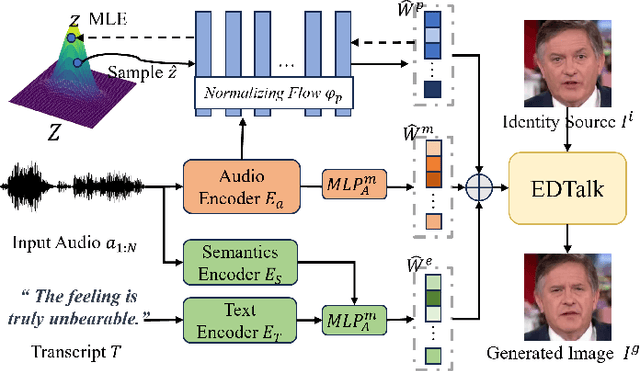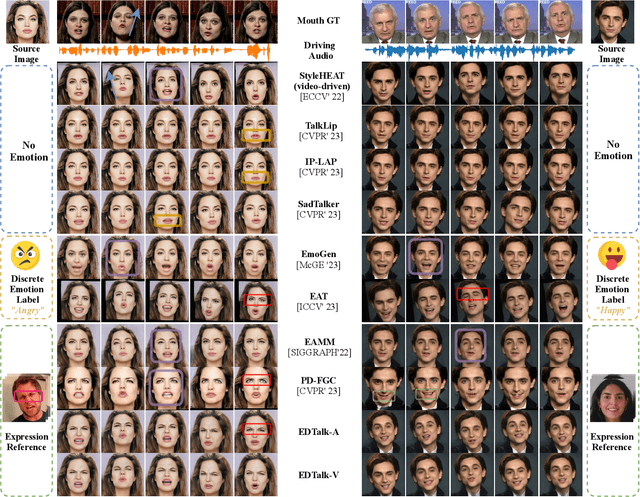Ye Pan
MienCap: Realtime Performance-Based Facial Animation with Live Mood Dynamics
Aug 06, 2025



Abstract:Our purpose is to improve performance-based animation which can drive believable 3D stylized characters that are truly perceptual. By combining traditional blendshape animation techniques with multiple machine learning models, we present both non-real time and real time solutions which drive character expressions in a geometrically consistent and perceptually valid way. For the non-real time system, we propose a 3D emotion transfer network makes use of a 2D human image to generate a stylized 3D rig parameters. For the real time system, we propose a blendshape adaption network which generates the character rig parameter motions with geometric consistency and temporally stability. We demonstrate the effectiveness of our system by comparing to a commercial product Faceware. Results reveal that ratings of the recognition, intensity, and attractiveness of expressions depicted for animated characters via our systems are statistically higher than Faceware. Our results may be implemented into the animation pipeline, and provide animators with a system for creating the expressions they wish to use more quickly and accurately.
MEDTalk: Multimodal Controlled 3D Facial Animation with Dynamic Emotions by Disentangled Embedding
Jul 08, 2025Abstract:Audio-driven emotional 3D facial animation aims to generate synchronized lip movements and vivid facial expressions. However, most existing approaches focus on static and predefined emotion labels, limiting their diversity and naturalness. To address these challenges, we propose MEDTalk, a novel framework for fine-grained and dynamic emotional talking head generation. Our approach first disentangles content and emotion embedding spaces from motion sequences using a carefully designed cross-reconstruction process, enabling independent control over lip movements and facial expressions. Beyond conventional audio-driven lip synchronization, we integrate audio and speech text, predicting frame-wise intensity variations and dynamically adjusting static emotion features to generate realistic emotional expressions. Furthermore, to enhance control and personalization, we incorporate multimodal inputs-including text descriptions and reference expression images-to guide the generation of user-specified facial expressions. With MetaHuman as the priority, our generated results can be conveniently integrated into the industrial production pipeline.
FixTalk: Taming Identity Leakage for High-Quality Talking Head Generation in Extreme Cases
Jul 02, 2025Abstract:Talking head generation is gaining significant importance across various domains, with a growing demand for high-quality rendering. However, existing methods often suffer from identity leakage (IL) and rendering artifacts (RA), particularly in extreme cases. Through an in-depth analysis of previous approaches, we identify two key insights: (1) IL arises from identity information embedded within motion features, and (2) this identity information can be leveraged to address RA. Building on these findings, this paper introduces FixTalk, a novel framework designed to simultaneously resolve both issues for high-quality talking head generation. Firstly, we propose an Enhanced Motion Indicator (EMI) to effectively decouple identity information from motion features, mitigating the impact of IL on generated talking heads. To address RA, we introduce an Enhanced Detail Indicator (EDI), which utilizes the leaked identity information to supplement missing details, thus fixing the artifacts. Extensive experiments demonstrate that FixTalk effectively mitigates IL and RA, achieving superior performance compared to state-of-the-art methods.
EmoFace: Audio-driven Emotional 3D Face Animation
Jul 17, 2024



Abstract:Audio-driven emotional 3D face animation aims to generate emotionally expressive talking heads with synchronized lip movements. However, previous research has often overlooked the influence of diverse emotions on facial expressions or proved unsuitable for driving MetaHuman models. In response to this deficiency, we introduce EmoFace, a novel audio-driven methodology for creating facial animations with vivid emotional dynamics. Our approach can generate facial expressions with multiple emotions, and has the ability to generate random yet natural blinks and eye movements, while maintaining accurate lip synchronization. We propose independent speech encoders and emotion encoders to learn the relationship between audio, emotion and corresponding facial controller rigs, and finally map into the sequence of controller values. Additionally, we introduce two post-processing techniques dedicated to enhancing the authenticity of the animation, particularly in blinks and eye movements. Furthermore, recognizing the scarcity of emotional audio-visual data suitable for MetaHuman model manipulation, we contribute an emotional audio-visual dataset and derive control parameters for each frames. Our proposed methodology can be applied in producing dialogues animations of non-playable characters (NPCs) in video games, and driving avatars in virtual reality environments. Our further quantitative and qualitative experiments, as well as an user study comparing with existing researches show that our approach demonstrates superior results in driving 3D facial models. The code and sample data are available at https://github.com/SJTU-Lucy/EmoFace.
Cost-Effective RF Fingerprinting Based on Hybrid CVNN-RF Classifier with Automated Multi-Dimensional Early-Exit Strategy
Jun 21, 2024



Abstract:While the Internet of Things (IoT) technology is booming and offers huge opportunities for information exchange, it also faces unprecedented security challenges. As an important complement to the physical layer security technologies for IoT, radio frequency fingerprinting (RFF) is of great interest due to its difficulty in counterfeiting. Recently, many machine learning (ML)-based RFF algorithms have emerged. In particular, deep learning (DL) has shown great benefits in automatically extracting complex and subtle features from raw data with high classification accuracy. However, DL algorithms face the computational cost problem as the difficulty of the RFF task and the size of the DNN have increased dramatically. To address the above challenge, this paper proposes a novel costeffective early-exit neural network consisting of a complex-valued neural network (CVNN) backbone with multiple random forest branches, called hybrid CVNN-RF. Unlike conventional studies that use a single fixed DL model to process all RF samples, our hybrid CVNN-RF considers differences in the recognition difficulty of RF samples and introduces an early-exit mechanism to dynamically process the samples. When processing "easy" samples that can be well classified with high confidence, the hybrid CVNN-RF can end early at the random forest branch to reduce computational cost. Conversely, subsequent network layers will be activated to ensure accuracy. To further improve the early-exit rate, an automated multi-dimensional early-exit strategy is proposed to achieve scheduling control from multiple dimensions within the network depth and classification category. Finally, our experiments on the public ADS-B dataset show that the proposed algorithm can reduce the computational cost by 83% while improving the accuracy by 1.6% under a classification task with 100 categories.
LR-FPN: Enhancing Remote Sensing Object Detection with Location Refined Feature Pyramid Network
Apr 02, 2024Abstract:Remote sensing target detection aims to identify and locate critical targets within remote sensing images, finding extensive applications in agriculture and urban planning. Feature pyramid networks (FPNs) are commonly used to extract multi-scale features. However, existing FPNs often overlook extracting low-level positional information and fine-grained context interaction. To address this, we propose a novel location refined feature pyramid network (LR-FPN) to enhance the extraction of shallow positional information and facilitate fine-grained context interaction. The LR-FPN consists of two primary modules: the shallow position information extraction module (SPIEM) and the contextual interaction module (CIM). Specifically, SPIEM first maximizes the retention of solid location information of the target by simultaneously extracting positional and saliency information from the low-level feature map. Subsequently, CIM injects this robust location information into different layers of the original FPN through spatial and channel interaction, explicitly enhancing the object area. Moreover, in spatial interaction, we introduce a simple local and non-local interaction strategy to learn and retain the saliency information of the object. Lastly, the LR-FPN can be readily integrated into common object detection frameworks to improve performance significantly. Extensive experiments on two large-scale remote sensing datasets (i.e., DOTAV1.0 and HRSC2016) demonstrate that the proposed LR-FPN is superior to state-of-the-art object detection approaches. Our code and models will be publicly available.
EDTalk: Efficient Disentanglement for Emotional Talking Head Synthesis
Apr 02, 2024



Abstract:Achieving disentangled control over multiple facial motions and accommodating diverse input modalities greatly enhances the application and entertainment of the talking head generation. This necessitates a deep exploration of the decoupling space for facial features, ensuring that they a) operate independently without mutual interference and b) can be preserved to share with different modal input, both aspects often neglected in existing methods. To address this gap, this paper proposes a novel Efficient Disentanglement framework for Talking head generation (EDTalk). Our framework enables individual manipulation of mouth shape, head pose, and emotional expression, conditioned on video or audio inputs. Specifically, we employ three lightweight modules to decompose the facial dynamics into three distinct latent spaces representing mouth, pose, and expression, respectively. Each space is characterized by a set of learnable bases whose linear combinations define specific motions. To ensure independence and accelerate training, we enforce orthogonality among bases and devise an efficient training strategy to allocate motion responsibilities to each space without relying on external knowledge. The learned bases are then stored in corresponding banks, enabling shared visual priors with audio input. Furthermore, considering the properties of each space, we propose an Audio-to-Motion module for audio-driven talking head synthesis. Experiments are conducted to demonstrate the effectiveness of EDTalk. We recommend watching the project website: https://tanshuai0219.github.io/EDTalk/
Say Anything with Any Style
Mar 13, 2024



Abstract:Generating stylized talking head with diverse head motions is crucial for achieving natural-looking videos but still remains challenging. Previous works either adopt a regressive method to capture the speaking style, resulting in a coarse style that is averaged across all training data, or employ a universal network to synthesize videos with different styles which causes suboptimal performance. To address these, we propose a novel dynamic-weight method, namely Say Anything withAny Style (SAAS), which queries the discrete style representation via a generative model with a learned style codebook. Specifically, we develop a multi-task VQ-VAE that incorporates three closely related tasks to learn a style codebook as a prior for style extraction. This discrete prior, along with the generative model, enhances the precision and robustness when extracting the speaking styles of the given style clips. By utilizing the extracted style, a residual architecture comprising a canonical branch and style-specific branch is employed to predict the mouth shapes conditioned on any driving audio while transferring the speaking style from the source to any desired one. To adapt to different speaking styles, we steer clear of employing a universal network by exploring an elaborate HyperStyle to produce the style-specific weights offset for the style branch. Furthermore, we construct a pose generator and a pose codebook to store the quantized pose representation, allowing us to sample diverse head motions aligned with the audio and the extracted style. Experiments demonstrate that our approach surpasses state-of-theart methods in terms of both lip-synchronization and stylized expression. Besides, we extend our SAAS to video-driven style editing field and achieve satisfactory performance.
Style2Talker: High-Resolution Talking Head Generation with Emotion Style and Art Style
Mar 12, 2024



Abstract:Although automatically animating audio-driven talking heads has recently received growing interest, previous efforts have mainly concentrated on achieving lip synchronization with the audio, neglecting two crucial elements for generating expressive videos: emotion style and art style. In this paper, we present an innovative audio-driven talking face generation method called Style2Talker. It involves two stylized stages, namely Style-E and Style-A, which integrate text-controlled emotion style and picture-controlled art style into the final output. In order to prepare the scarce emotional text descriptions corresponding to the videos, we propose a labor-free paradigm that employs large-scale pretrained models to automatically annotate emotional text labels for existing audiovisual datasets. Incorporating the synthetic emotion texts, the Style-E stage utilizes a large-scale CLIP model to extract emotion representations, which are combined with the audio, serving as the condition for an efficient latent diffusion model designed to produce emotional motion coefficients of a 3DMM model. Moving on to the Style-A stage, we develop a coefficient-driven motion generator and an art-specific style path embedded in the well-known StyleGAN. This allows us to synthesize high-resolution artistically stylized talking head videos using the generated emotional motion coefficients and an art style source picture. Moreover, to better preserve image details and avoid artifacts, we provide StyleGAN with the multi-scale content features extracted from the identity image and refine its intermediate feature maps by the designed content encoder and refinement network, respectively. Extensive experimental results demonstrate our method outperforms existing state-of-the-art methods in terms of audio-lip synchronization and performance of both emotion style and art style.
FlowVQTalker: High-Quality Emotional Talking Face Generation through Normalizing Flow and Quantization
Mar 12, 2024Abstract:Generating emotional talking faces is a practical yet challenging endeavor. To create a lifelike avatar, we draw upon two critical insights from a human perspective: 1) The connection between audio and the non-deterministic facial dynamics, encompassing expressions, blinks, poses, should exhibit synchronous and one-to-many mapping. 2) Vibrant expressions are often accompanied by emotion-aware high-definition (HD) textures and finely detailed teeth. However, both aspects are frequently overlooked by existing methods. To this end, this paper proposes using normalizing Flow and Vector-Quantization modeling to produce emotional talking faces that satisfy both insights concurrently (FlowVQTalker). Specifically, we develop a flow-based coefficient generator that encodes the dynamics of facial emotion into a multi-emotion-class latent space represented as a mixture distribution. The generation process commences with random sampling from the modeled distribution, guided by the accompanying audio, enabling both lip-synchronization and the uncertain nonverbal facial cues generation. Furthermore, our designed vector-quantization image generator treats the creation of expressive facial images as a code query task, utilizing a learned codebook to provide rich, high-quality textures that enhance the emotional perception of the results. Extensive experiments are conducted to showcase the effectiveness of our approach.
 Add to Chrome
Add to Chrome Add to Firefox
Add to Firefox Add to Edge
Add to Edge